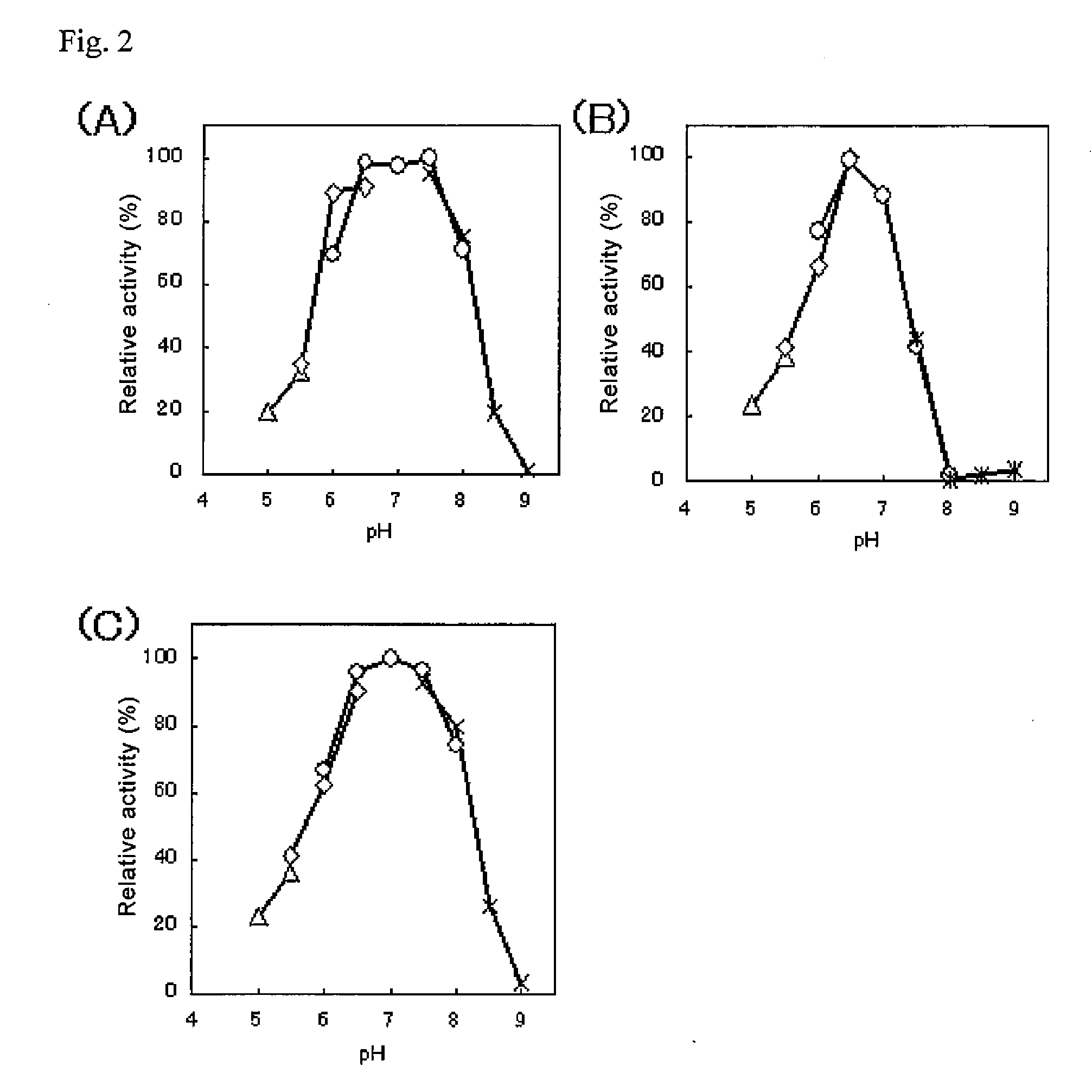E. coli transformant, method for producing flavin-bound glucose dehydrogenase using the same, and mutant flavin-bound glucose dehydrogenases
a technology of d-glucose and transformant, which is applied in the field of e. coli transformant, can solve the problems of affecting measurements, enzyme instability, and affecting the accuracy of measurement, and achieves accurate measurement of d-glucose, efficient extraction, and accurate measurement of glucos
- Summary
- Abstract
- Description
- Claims
- Application Information
AI Technical Summary
Benefits of technology
Problems solved by technology
Method used
Image
Examples
example 1
Acquisition of a Flavin-Bound GDH Derived from Mucor
1. Screening of GDH-Producing Cells
[0090]Strains isolated from natural environments and about 500 stored strains supplied by a culture collection institution (Noda Institute for Scientific Research) were screened for GDH production. Each bacterial strain under test was inoculated into 3 mL of malt extract medium (2.0% malt extract, 2.0% D-glucose, 0.1% polypeptone, pH 6.0), followed by shaking culture at 30° C. for 3-5 days. The culture medium was centrifuged at 800×g for 10 minutes to precipitate cells. Subsequently, the cells were suspended in 10 mM acetate buffer (pH 5.0) and homogenized using a Multi-beads Shocker (Yasui Kikai) (2,000 rpm, 60 seconds, 16 times). The supernatant collected by centrifugation at 20,000×g and 4° C. for 10 minutes was used as a crude enzyme solution.
2. Determination of GDH Activity
[0091]Solutions were mixed according to the following procedures, followed by absorbance measurement to examine GDH acti...
example 2
Purification of a Flavin-Bound GDH Derived from Mucor
[0095]To a 0.5 L Sakaguchi flask, 0.1 L of preculture medium (2.0% yeast extract, 4% glucose, pH 6.0) was added. Into the flask, about 1 cm2 each of a preculture of Mucor prainii NISL0103, Mucor javanicus NISL0111, or Mucor circinelloides f. circinelloides NISL0117 on a plate was inoculated, followed by shaking culture at 130 rpm and 30° C. for two days. This was used as a seed culture. Into 20 L of the above medium in a 30 L jar fermenter (two jar fermenters), 0.2 L each of the seed culture was inoculated, followed by culture at 200 rpm, 30° C., and 0.5 vvm for three days. After the completion of the culture, 40 L of culture medium was filtered through a filter cloth to collect cells. Subsequently, the obtained cells were suspended in 10 mM acetate buffer (pH 5.0).
[0096]The above cells suspension was sent to a Dyno-Mill (150 mL / min) and homogenized. The supernatant was collected by centrifugation at 6,000×g for 30 minutes. This ...
example 3
Investigation of the Enzymatic Properties of Flavin-Bound GDH Derived from Mucor
[0099]The properties of the purified GDHs obtained in Example 2 were investigated.
(a) Measurement of Absorption Spectra
[0100]MpGDH, MjGDH, and McGDH were dialyzed using 10 mM acetate buffer (pH 5.0), followed by the measurement of absorption spectra at 250-800 nm using a spectrophotometer U-3010 (Hitachi High-Technologies Co., Ltd.). FIG. 1 shows the measurement results (FIGS. 1 (A), (B), and (C) show the absorption spectra of MpGDH, MjGDH, and McGDH, respectively.). All the GDHs showed two maximal peaks at around 340-350 and 420-430 nm wavelengths, strongly suggesting that the GDHs of the invention are flavin-bound proteins because these absorption spectra are specific to a flavin enzyme.
(b) Measurement of GOD Activity
[0101]MpGDH, MjGDH, and McGDH obtained in Example 2 and a commercial glucose oxidase derived from Aspergillus niger (GOD, biozyme laboratories) were used to measure GDH and GOD activities...
PUM
| Property | Measurement | Unit |
|---|---|---|
| Fraction | aaaaa | aaaaa |
| Volume | aaaaa | aaaaa |
| Volume | aaaaa | aaaaa |
Abstract
Description
Claims
Application Information
 Login to View More
Login to View More - R&D
- Intellectual Property
- Life Sciences
- Materials
- Tech Scout
- Unparalleled Data Quality
- Higher Quality Content
- 60% Fewer Hallucinations
Browse by: Latest US Patents, China's latest patents, Technical Efficacy Thesaurus, Application Domain, Technology Topic, Popular Technical Reports.
© 2025 PatSnap. All rights reserved.Legal|Privacy policy|Modern Slavery Act Transparency Statement|Sitemap|About US| Contact US: help@patsnap.com



